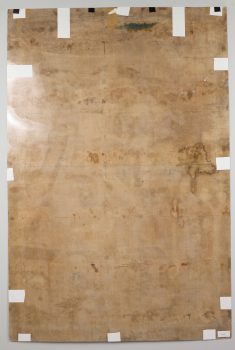Central Tibet
ca. 1590
This is the gesture of the Buddha calling the earth to witness his awakening.
Central Tibet
ca. 1590


This painting depicts Wangchuk Dorje, the Ninth Black Hat Karmapa, head of the Karma Kagyu School of Tibetan Buddhism. A partly effaced inscription suggests that this painting was executed during the Ninth Karmapa’s lifetime, which is also supported by a small visual clue in the painting’s background. Just over the right shoulder of the central figure a monumental image of the Buddha can be seen unfurled on a mountainside. This is a depiction of a famous appliqué scroll of Buddha Shakyamuni, which was made at the Karmapa’s home monastery, Tsurphu, for the Ninth Karmapa in 1585.The Encampment (Gardri) artistic style, a popular painting tradition that combined Tibetan and Chinese aesthetics, took shape in the court of the Ninth Karmapa, and while no examples of the early Encampment style painted by the tradition’s founder, the great artist Namkha Tashi, have as of yet been identified, this painting is as close as we can come for now. Stylistically it marks a distinct departure from the previous tradition of depicting the Karma Kagyu School lineage. It has a more open composition and naturalistic sense of receding space, a trait that characterizes later Encampment paintings of the eighteenth and nineteenth centuries.
The passing down of authentic Buddhist teachings from a teacher to a disciple or student, often in the form of a text in a ritualistic context.
The transmission of teachings from one generation to the next, from teacher to student, traced all the way back to the Buddha without interruption. A complete lineage is essential in Tantric Buddhist practices as it makes the blessings of the teaching more powerful.
Himalayan art includes portraits of legendary and historical humans, including accomplished religious teachers (lamas), the Buddha’s original disciples (arhats), and spiritually accomplished tantric masters (mahasiddhas).
Today, Tibetans primarily inhabit the Tibetan Plateau, situated between the Himalayan mountain range and the Indian subcontinent to the west, Chinese cultural regions to the east, and Mongolian cultural regions to the northeast. During the 7th to 9th century, Tibetan rulers expanded their empire across Central Asia, and established Buddhism as the state religion.
Get the latest news and stories from the Rubin, plus occasional information on how to support our work.